I loved the suggestion to discover La Perouse. Apart from vaguely knowing where it is, and that it has Aboriginal significance, I know very little about the suburb. After feeling unsettled when walking alone through the bush in Bundeena, I sent out a call for friends to join me today and so unusually I will not be alone.
From Central Station, I make my way to the bus stop. Soon, I hear familiar voices. My two girlfriends have found each other and are chatting away. We board the bus and enjoy the drive out of the city to the end of ANZAC Parade.
Welcome to La Perouse
A faded sign welcomes us to La Perouse, named after a French navigator who arrived a few days after Arthur Phillip. Across the road the ‘snake pit’ is empty. Snake performances have been running here since the late 1800’s and you can still see them on Sunday afternoons.
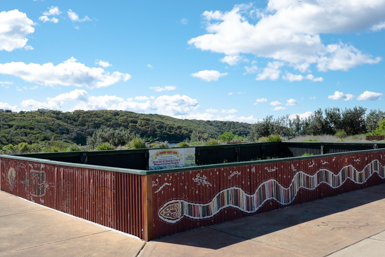
The Snake Pit
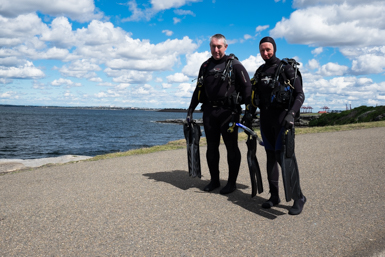
About to dive in
Barrack Tower
I am excited to recognise a sandstone structure that I read about in my research. The octagonal Barrack Tower, Randwick’s oldest building, was built in around 1821. Originally a lookout it became a customs post controlling local smuggling and assisting with capturing escaped convicts.
Scuba Diving
La Perouse has a small population, with the suburb mostly taken up by the New South Wales Golf Course and Botany Bay National Park. One of the few suburbs of Sydney with a French name, it is a well-known scuba diving spot.
A couple of divers are preparing themselves and their oxygen tanks. The woman tells me that they will see plenty of soft coral, fish and perhaps a seaweed dragon which apparently looks a little like an elongated sea horse.
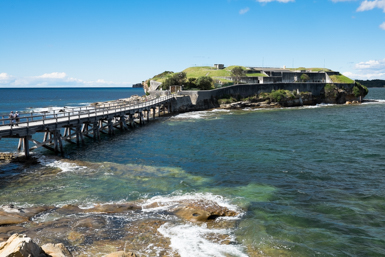
Bare Island

Low Tide
Bare Island
We walk along the path and cross the bridge to Bare Island. An old military outpost, it is now a museum and tourist attraction only accessible by guided tour. As it’s low tide, we make our way down stairs to the rock platform below. A sign warns us that there have been four deaths in the area and we take care as we walk around the base of the island.
A fisherman reeling in his empty line tells me that he caught a Sergeant Baker this morning. I’ll have to find out what it looks like when I get home. We admire the lovely examples of honeycomb rock weathering before retracing our steps.

Sandstone Patterns

La Perouse Monument
Recent History
In the distance are the large yellow and red cranes of Port Botany, while across the parkland is another piece of recent history. The obelisk shaped La Perouse monument looms tall behind a cast iron fence. We wonder about the numerous brass plaques, some as recent as 1969, screwed into the base.
The grave of L. Receveur, a French chaplain and scientist on La Perouse’s voyage is similarly behind a locked metal gate. He was the second European to be buried on Australian soil.
Indigenous Significance
La Perouse is an area of special indigenous significance. By 1895, there was an Aboriginal reserve in La Perouse as well as Aboriginal missions. Yarra Bay House, now owned by the La Perouse Local Aboriginal Land Council was originally part of a telegraph cable communication station and later a series of children’s homes. It is now the La Perouse museum. Weekly guided tours tell stories of the local area and the local indigenous people.
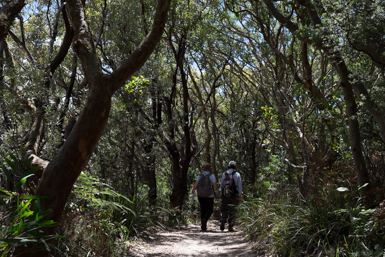
Henry Head Walk

Bare Island in the distance
Henry Head Walk
I was hoping for a cup of tea, but The Boathouse is closed for renovations. Instead, we set off on the Henry Head Walk. The flies are particularly annoying today. I find myself waving my hand repeatedly in front of my face in the manner of an ‘Aussie Salute’.
The route is relatively easy and well signposted. The wide path is mostly flat with a few steep sections. It’s a pleasant walk passing through bush, wide open areas and a lovely forest of angophoras. I am glad that I followed the advice to wear sun protection and carry water. The sun is particularly fierce out in the open.
Congwong Beach
A woman sits meditating on Congwong Beach, drinking in the scenery and enjoying the quiet of the water lapping the shore. We leave her in peace. Suddenly high pitched shrieks shatter the silence. A bather has discovered that the water is colder than expected. We feel for the woman whose solitude has been disrupted.

Art or vandalism?

What do you think
As the side path descends to Little Congwong Beach I notice a bronzed figure walking along the sand and recall that this is a nudist beach. My warning comes too late for my companions. We leave the nude sunbathers, return to the main track and are rewarded with impressive views back to Bare Island.
Even though the track is well maintained easy to follow, my friends agree that they would be spooked walking here alone. I must admit I’m glad of the company.
The diversion to Browns Rock is a disappointment. There’s nothing much to see. A group of young people are trying their hand at fishing from the narrow rock shelf. I am happy to move on.
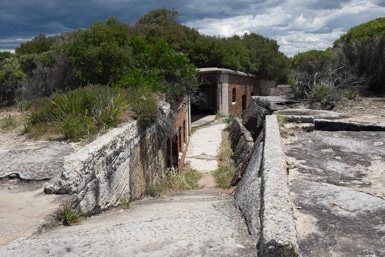
World War Battlements

Bridge to the next tee
Continuing along the path we first come across a World War 1 fort and then historic World War II battlements which were part of Sydney’s early coastal defence systems. I’ll let you decide what you think of the graffiti.
Cape Banks
A beautiful large rock platform beckons and we decide to walk on to Cape Banks. The path cuts across the golf course where a large group of black crows have found some sort of nourishment on the green. We cross a narrow metal bridge towards to the tee for the sixth hole, but don’t venture as far as Cape Banks headland. Returning the way we have come, we enjoy each other’s company, and the beauty of the bush so close to the city.

Bare Island Again
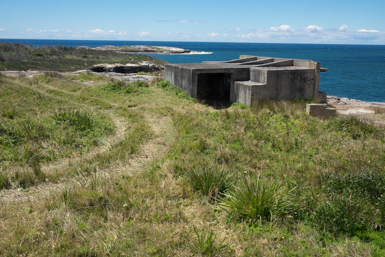
Cape Banks in the distance
It is time for lunch. Being hot and sticky we opt for the more casual Danny’s Seafood cafe instead of the restaurant with its white table cloths and sweeping views. Embarrassingly, as we sit down, clouds of flies surround us. We probably brought them in. By the time our tasty fish, chips and salad arrive, they’ve disappeared, and we eat in peace.
La Perouse has been interesting
We’ve timed things perfectly. It starts to rain as we walk to the bus stop where our bus is waiting. I’ve had yet another interesting suburban discovery want to return one Sunday to visit the museum, tour Bare Island and see the snake show.
Useful information:
La Perouse is 14km south east of the Sydney CBD
Plan your trip at transportnsw.info
Click here for the Henry Head Walking Track.
And here for more detailed directions.
And a map to assist you: You can download it here. (NOTE that I take an average of 4-5 hours when I explore):

We continued to Cape Banks. Path not marked

Comments
As a child used to go there often on weekends with my family. Remember the snakes but thought there was a shop made of shells? Thanks for the memories!
I think you would find a few changes there now, Cathy. There are a few new terraces and not any shop made of shells that I could see. I am pleased to have taken you back to your childhood. Joanne
This looks like an interesting place to visit, it has history, nature and art………definitely art.
Thanks Bernadette you have it in one.
Another interesting day out Jo. Keep up these interesting trips. I enjoy every one of them.
Thanks Marie. Comments like yours encourage me to keep going.
Thanks Jo,
Your walks are always full of interesting little titbits 🙂 I look forward to seeing you on a walk around Narrabeen Lagoon.
Cheers,
Philip.
ps I found a photo of the Sergeant Baker – what a gorgeous looking fish!
http://australianmuseum.net.au/uploads/comments/384/sergeant%20baker%20dsc_4180.jpg
Thanks Philip. It is a pretty fish, and I’ll have to make Narrabeen a destination for next year. Jo
Pingback: Why whale watching in Sydney is a good idea | Plan a trip to Sydney
Thank you for your post. La Perouse is a very pretty place with a fascinating Indigenous and European history. Little Congwong is arguably Sydney’s very best nudist beach.
Thanks for reading, Tim. As you say, the history of the area is fascinating.